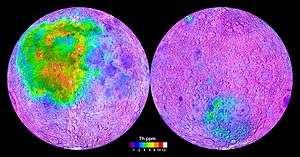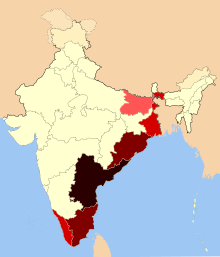Occurrence of thorium


Thorium is found in small amounts in most rocks and soils; it is three times more abundant than tin in the Earth's crust and is about as common as lead.[1] Soil commonly contains an average of around 6 parts per million (ppm) of thorium.[2] Thorium occurs in several minerals including thorite (ThSiO4), thorianite (ThO2 + UO2) and monazite. Thorianite is a rare mineral and may contain up to about 12% thorium oxide. Monazite contains 2.5% thorium, allanite has 0.1 to 2% thorium and zircon can have up to 0.4% thorium.[3] Thorium-containing minerals occur on all continents.[4][5][6] Thorium is several times more abundant in Earth's crust than all isotopes of uranium combined and thorium-232 is several hundred times more abundant than uranium-235.[7]
Thorium concentrations near the surface of the earth can be mapped using gamma spectroscopy. The same technique has been used to detect concentrations on the surface of the Moon; the near side has high abundances of relatively thorium-rich KREEP, while the Compton–Belkovich Thorium Anomaly was detected on the far side. Martian thorium has also been mapped by 2001 Mars Odyssey.[8]
232Th decays very slowly (its half-life is comparable to the age of the universe) but other thorium isotopes occur in the thorium and uranium decay chains. Most of these are short-lived and hence much more radioactive than 232Th, though on a mass basis they are negligible.
Thorium reserve estimates

2012 reserve estimates:[9]
Present knowledge of the distribution of thorium resources is poor because of the relatively low-key exploration efforts arising out of insignificant demand.[10] There are two sets of estimates that define world thorium reserves, one set by the United States Geological Survey (USGS) and the other supported by reports from the OECD and the International Atomic Energy Agency (the IAEA). Under the USGS estimate, United States, Australia, and India have particularly large reserves of thorium.
India and Australia are believed to possess about 300,000 tonnes each; i.e. each has 25% of the world's thorium reserves.[11] In the OECD reports, however, estimates of Australia's Reasonably Assured Reserves (RAR) of thorium indicate only 19,000 tonnes and not 300,000 tonnes as indicated by USGS. The two sources vary wildly for countries such as Brazil, Turkey, and Australia, but both reports appear to show some consistency with respect to India's thorium reserve figures, with 290,000 tonnes (USGS) and 319,000 tonnes (OECD/IAEA).
Both the IAEA and OECD appear to conclude that India may possess the largest share of world's thorium deposits.
The IAEA's 2005 report estimates India's reasonably assured reserves of thorium at 319,000 tonnes, but mentions recent reports of India's reserves at 650,000 tonnes.[12] A government of India estimate, shared in the country's Parliament in August 2011, puts the recoverable reserve at 846,477 tonnes.[13] The Indian Minister of State V. Narayanasamy stated that as of May 2013, the country's thorium reserves were 11.93 million tonnes (monazite, having 9-10% ThO2[9]), with a significant majority (8.59 Mt; 72%) found in the three eastern coastal states of Andhra Pradesh (3.72 Mt; 31%), Tamil Nadu (2.46 Mt; 21%) and Odisha (2.41 Mt; 20%).[14]
The prevailing estimate of the economically available thorium reserves comes from the USGS, Mineral Commodity Summaries (1996–2010):[6][15]
| Country | Reserves |
|---|---|
| Australia | 300,000 |
| India | 290,000 |
| Norway | 170,000 |
| United States | 160,000 |
| Canada | 100,000 |
| South Africa | 35,000 |
| Brazil | 16,000 |
| Other Countries | 95,000 |
| World Total | 1,200,000 |
| Country | Reserves |
|---|---|
| India | 963,000 |
| United States | 440,000 |
| Australia | 300,000 |
| Canada | 100,000 |
| South Africa | 35,000 |
| Brazil | 16,000 |
| Malaysia | 4,500 |
| Other Countries | 90,000 |
| World Total | 1,913,000 |
Note: The OECD/NEA report notes that the estimates (that the Australian figures are based on) are subjective, due to the variability in the quality of the data, a lot of which is old and incomplete.[17] Adding to the confusion are subjective claims made by the Australian government (in 2009, through its Geoscience department) that combine the reasonably assured reserves (RAR) estimates with "inferred" data (i.e. subjective guesses). This strange combined figure of RAR and "guessed" reserves yields a figure, published by the Australian government, of 489,000 tonnes,[17] however, using the same criteria for Brazil or India would yield reserve figures of between 600,000 and 1,300,000 tonnes for Brazil and between 300,000 and 600,000 tonnes for India. Irrespective of isolated claims by the Australian government, the most credible third-party and multi-lateral reports, those of the OECD/IAEA and the USGS, consistently report high thorium reserves for India while not doing the same for Australia.
Another estimate of reasonably assured reserves (RAR) and estimated additional reserves (EAR) of thorium comes from OECD/NEA, Nuclear Energy, "Trends in Nuclear Fuel Cycle", Paris, France (2001):[18]
| Country | RAR Th | EAR Th |
|---|---|---|
| India | 519,000 | 21% |
| Australia | 489,000 | 19% |
| USA | 400,000 | 13% |
| Turkey | 344,000 | 11% |
| Venezuela | 302,000 | 10% |
| Brazil | 302,000 | 10% |
| Norway | 132,000 | 4% |
| Egypt | 100,000 | 3% |
| Russia | 75,000 | 2% |
| Greenland | 54,000 | 2% |
| Canada | 44,000 | 2% |
| South Africa | 18,000 | 1% |
| "Other countries" | 33,000 | 2% |
| "World total" | 2,810,000 | |
The preceding reserve figures refer to the amount of thorium in high-concentration deposits inventoried so far and estimated to be extractable at current market prices; millions of times more total exist in Earth's 3×1019 tonne crust, around 120 trillion tons of thorium, and lesser but vast quantities of thorium exist at intermediate concentrations.[19][20][21] Proved reserves are the standard method of indicated available economics sources.
The Lemhi Pass, along the Idaho-Montana border, has one of the world's largest known high-quality thorium deposits. Thorium Energy, Inc. has the mineral rights to approximately 1360 acres (5.5 sq km) of it and states that they have proven thorium oxide reserves of 600 thousand tons and probable reserves of an additional 1.8 million tons within their claim.[22]
In event of a thorium fuel cycle, Conway granite with 56 (±6) parts per million thorium could provide a major low-grade resource; a 307 sq mile (795 sq km) "main mass" in New Hampshire is estimated to contain over three million metric tons per 100 feet (30 m) of depth (i.e. 1 kg thorium in eight cubic metres of rock), of which two-thirds is "readily leachable".[23] Even common granite rock with 13 PPM thorium concentration (just twice the crustal average, along with 4 ppm uranium) contains potential nuclear energy equivalent to 50 times the entire rock's mass in coal,[24] although there is no incentive to resort to such very low-grade deposits so long as much higher-grade deposits remain available and cheaper to extract.[25] Thorium has been produced in excess of demand from the refining of rare earth elements.[26]
References
- ↑ Wickleder 2006, p. 55.
- ↑ THORIUM Agency for Toxic Substances and Disease Registry. July 1999.
- ↑ Wickleder 2006, p. 56.
- ↑ Hammond, C. R. (2004). The Elements, in Handbook of Chemistry and Physics 81st edition. CRC press. ISBN 0-8493-0485-7.
- ↑ "Monazite-(Ce): Monazite-(Ce) mineral information and data". Retrieved 18 May 2009.
- 1 2 "U.S. Geological Survey, Mineral Commodity Summaries – Thorium".
- ↑ Wickleder 2006, p. 53.
- ↑ Lunar & Planetary Lab at The University of Arizona January 2008: Thorium Map
- 1 2 "DETAILS OF THORIUM RESERVES". Department of Atomic Energy (India). 10 May 2012.
- ↑ Jayaram, K.M.V. "An Overview of World Thorium Resources, Incentives for Further Exploration and Forecast for Thorium Requirements in the Near Future" (PDF). Archived from the original (PDF) on June 28, 2011.
- ↑ "US approves Indian nuclear deal". BBC News. 9 December 2006.
- ↑ IAEA: Thorium fuel cycle — Potential benefits and challenges (PDF). p. 45.
- ↑ "Availability of Thorium". Press Information Bureau, Government of India. 10 August 2011. Retrieved 27 March 2012.
- ↑ Press Trust of India (14 August 2013). "Over 1.25 MT thorium reserve found in 3 years". Business Standard. Retrieved 22 August 2013.
- ↑ "Information and Issue Briefs – Thorium". World Nuclear Association. Retrieved 1 November 2006.
- ↑ "Status of Nuclear Power: A Global View. Y.A Sokolov 2005 IAEA" (PDF).
- 1 2 "Thorium – AIMR 2009". Australian Mines Atlas. Retrieved 1 June 2009.
- ↑ IAEA: Thorium fuel cycle — Potential benefits and challenges (PDF). pp. 45(table 8), 97(ref 78).
- ↑ Ragheb, M. (12 August 2011) Thorium Resources In Rare Earth Elements. scribd.com
- ↑ American Geophysical Union, Fall Meeting 2007, abstract #V33A-1161. Mass and Composition of the Continental Crust
- ↑ James D. Gwartney, Richard L. Stroup, Russell S. Sobel, David MacPherson. Economics: Private and Public Choice, 12th Edition. South-Western Cengage Learning, p. 730
- ↑ Lemhi Pass Thorium. thoriumenergy.com
- ↑ Adams, JA; Kline, MC; Richardson, KA; Rogers, JJ (1962). "The Conway Granite of New Hampshire As a Major Low-Grade Thorium Resource". Proceedings of the National Academy of Sciences of the United States of America. 48 (11): 1898–905. Bibcode:1962PNAS...48.1898A. doi:10.1073/pnas.48.11.1898. PMC 221093
 . PMID 16591014.
. PMID 16591014. - ↑ Hubbert, M. King Nuclear Energy and the Fossil Fuels. American Petroleum Institute Conference, 8 March 1956. Republished on 8 March 2006, by the Energy Bulletin.
- ↑ Brown, Harrison (1954). The Challenge of Man's Future. New York: Viking Press.
- ↑ Hedrick, James B. (1997) Thorium. US Geological Survey.
Bibliography
- Wickleder, Mathias S.; Fourest, Blandine; Dorhourt, Peter K. (2006). "Thorium". In Morss, Lester R.; Edelstein, Norman M.; Fuger, Jean. The Chemistry of the Actinide and Transactinide Elements (3rd ed.). Springer Science+Business Media. ISBN 1-4020-3555-1.